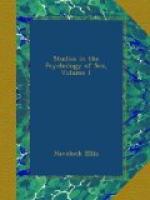[101] Pouchet, Theorie de l’Ovulation Spontanee, 1847. As Blair Bell and Pontland Hick remark ("Menstruation,” British Medical Journal, March 6, 1909), the repeated oestrus of unimpregnated animals (once a fortnight in rabbits) is surely comparable to menstruation.
[102] Tait, Provincial Medical Journal, May, 1891; J. Beard, The Span of Gestation, 1897, p. 69. Lawson Tait is reduced to the assertion that ovulation and menstruation are identical.
[103] As Moll points out, even the secondary sexual characters have undergone a somewhat similar change. The beard was once an important sexual attraction, but men can now afford to dispense with it without fear of loss in attractiveness. (Libido Sexualis, Band I, p. 387.) These points are discussed at greater length in the fourth volume of these Studies, “Sexual Selection in Man.”
[104] It is not absolutely established that in menstruating animals the period of menstruation is always a period of sexual congress; probably not, the influence of menstruation being diminished by the more fundamental influence of breeding seasons, which affect the male also; monkeys have a breeding season, though they menstruate regularly all the year round.
[105] See Appendix A.
[106] Bland Sutton, loc. cit., p. 896.
[107] See H. Ellis, Man and Woman, Chapter XI.
[108] This is by no means true of European women only. Thus, we read in an Arabic book, The Perfumed Garden, that women have an aversion to coitus during menstruation. On the other hand, the old Hindoo physician, Susruta, appears to have stated that a tendency to run after men is one of the signs of menstruation.
[109] The actual period of the menstrual flow corresponds, in Heape’s terminology, to the congestive stage, or pro-oestrum, in female animals; the oestrus, or period of sexual desire, immediately follows the pro-oestrum, and is the direct result of it. See Heape, “The ’Sexual Season’ of Mammals,” Quarterly Journal of Microscopical Science, 1900, vol. xliv, Part I.
[110] It may be noted that (as Barnes, Oliver, and others have pointed out) there is heightened blood-pressure during menstruation. Haig remarks that he has found a tendency for high pressure to be accompanied by increased sexual appetite (Uric Acid, 6th edition, p. 155).




